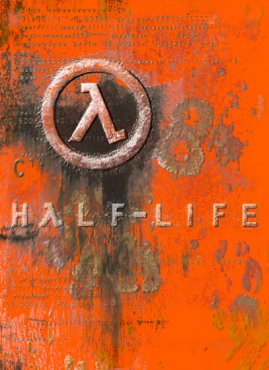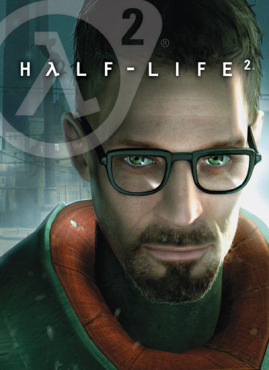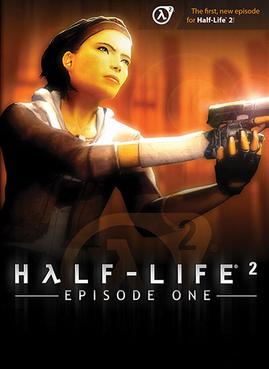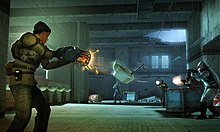
Half-Life is a 1998 first-person shooter (FPS) game developed by Valve Corporation and published by Sierra Studios for Windows. It was Valve's debut product and the first game in the Half-Life series. The player assumes the role of Gordon Freeman, a scientist who must escape from the Black Mesa Research Facility after it is invaded by aliens following a disastrous scientific experiment. The gameplay consists of combat, exploration and puzzles.

Doom 3 is a 2004 survival horror first-person shooter video game developed by id Software and published by Activision. Doom 3 was originally released for Microsoft Windows on August 3, 2004, adapted for Linux later that year, and ported by Aspyr Media for Mac OS X in 2005. Developer Vicarious Visions ported the game to the Xbox, releasing it worldwide on April 4, 2005.

Half-Life 2 is a 2004 first-person shooter (FPS) game developed and published by Valve Corporation. It was published for Windows on Valve's digital distribution service, Steam. Like the original Half-Life (1998), Half-Life 2 combines shooting, puzzles, and storytelling, and adds new features such as vehicles and physics-based gameplay. The player controls Gordon Freeman, who joins a resistance to liberate Earth from the alien Combine empire.
Shooter video games or shooters are a subgenre of action video games where the focus is almost entirely on the defeat of the character's enemies using the weapons given to the player. Usually these weapons are firearms or some other long-range weapons, and can be used in combination with other tools such as grenades for indirect offense, armor for additional defense, or accessories such as telescopic sights to modify the behavior of the weapons. A common resource found in many shooter games is ammunition, armor or health, or upgrades which augment the player character's weapons.

Gordon Freeman is the silent protagonist of the Half-Life video game series, created by Gabe Newell and designed by Newell and Marc Laidlaw of Valve. His first appearance is in Half-Life. Gordon Freeman is depicted as a bespectacled white man from Seattle, with brown hair and a signature goatee, who graduated from MIT with a PhD in theoretical physics. He was an employee at the fictional Black Mesa Research Facility. Controlled by the player, Gordon is often tasked with using a wide range of weapons and tools to fight alien creatures such as headcrabs, as well as Combine machines and soldiers. Gordon Freeman's character has been well received by critics and gamers, and various gaming websites often consider him to be one of the greatest video game characters of all time, including UGO and GameSpot.

Doom 3: Resurrection of Evil is a survival horror first-person shooter video game developed by Nerve Software and published by Activision. It was released for Microsoft Windows worldwide on April 4, 2005, as an expansion pack and sequel to Doom 3 and on October 5, 2005, for the Xbox video game console. The Xbox version does not require the original Doom 3 in order to play, and includes The Ultimate Doom, Doom II: Hell on Earth and Master Levels for Doom II.

The Combine are a fictional multidimensional empire which serve as the primary antagonistic force in the 2004 video game Half-Life 2 and its subsequent episodes developed and published by Valve Corporation. The Combine consist of organic, synthetic, and heavily mechanized elements. They are encountered throughout Half-Life 2, Half-Life 2: Episode One, and Half-Life 2: Episode Two, as well as Half-Life: Alyx, as hostile non-player characters as the player progresses through the games in an effort to overthrow the Combine occupation of Earth.
Alyx Vance is a fictional character from Valve's Half-Life video game series. She is introduced as a non-playable, supporting character in Half-Life 2 (2004), accompanying the player's character, Gordon Freeman, throughout much of the game. She subsequently appears in a similar capacity in Half-Life 2: Episode One (2006) and Episode Two (2007), and as the titular protagonist of the VR game Half-Life: Alyx (2020).

Ravenholm is a fictional ghost town in the first-person shooter game Half-Life 2, developed by Valve Corporation and released in 2004. It serves as the primary setting for the game's sixth chapter, "We Don't Go to Ravenholm", which follows the game's protagonist Gordon Freeman as he journeys through the area as part of an escape from Black Mesa East after it is attacked by Combine forces in order to reach a nearby Resistance outpost. Ravenholm is a mining town in Eastern Europe destroyed by a Combine bombardment using headcrabs that turned its residents into hostile zombies, its sole survivor, Father Grigori, offers his assistance to Freeman throughout the level, culminating in a last stand at the town's cemetery.

Half-Life 2: Episode One is a 2006 first-person shooter game developed and published by Valve for Windows. It continues the story of Half-Life 2 (2004); as scientist Gordon Freeman, players must escape City 17 with Gordon's companion Alyx Vance. Like previous Half-Life games, Episode One combines shooting, puzzles and storytelling.
Computer animation physics or game physics are laws of physics as they are defined within a simulation or video game, and the programming logic used to implement these laws. Game physics vary greatly in their degree of similarity to real-world physics. Sometimes, the physics of a game may be designed to mimic the physics of the real world as accurately as is feasible, in order to appear realistic to the player or observer. In other cases, games may intentionally deviate from actual physics for gameplay purposes. Common examples in platform games include the ability to start moving horizontally or change direction in mid-air and the double jump ability found in some games. Setting the values of physical parameters, such as the amount of gravity present, is also a part of defining the game physics of a particular game.

Half-Life 2: Episode Two is a 2007 first-person shooter game developed and published by Valve. Following Episode One (2006), it is the second of two shorter episodic games that continue the story of Half-Life 2 (2004). Players control Gordon Freeman, who travels through the mountains surrounding City 17 to a resistance base with his ally Alyx Vance. Like previous games in the series, Episode Two combines shooting, puzzle-solving and narrative elements, but adds expansive environments and less linear sequences.

Half-Life is a series of first-person shooter (FPS) games created by Valve. The games combine shooting combat, puzzles and storytelling.
This is a list of characters in the Half-Life video game series, which comprises Half-Life, Half-Life 2, Half-Life: Alyx, and their respective expansion packs and episodes.
The Razer Hydra is a motion and orientation detection game controller developed by Sixense Entertainment, a company founded in 2007, in partnership with Razer USA. It uses a weak magnetic field to detect the absolute position and orientation of the controllers with a precision, as stated by its developers, of 1 mm and 1°; it has six degrees of freedom. The original release is wired, but a wireless version was also in development.

A first-person shooter (FPS) is a video game centered on gun fighting and other weapon-based combat seen from a first-person perspective, with the player experiencing the action directly through the eyes of the main character. This genre shares multiple common traits with other shooter games, and in turn falls under the action games category. Since the genre's inception, advanced 3D and pseudo-3D graphics have proven fundamental to allow a reasonable level of immersion in the game world, and this type of game helped pushing technology progressively further, challenging hardware developers worldwide to introduce numerous innovations in the field of graphics processing units. Multiplayer gaming has been an integral part of the experience, and became even more prominent with the diffusion of internet connectivity in recent years.
Portal is a series of first-person puzzle-platform video games developed by Valve. Set in the Half-Life universe, the two main games in the series, Portal (2007) and Portal 2 (2011), center on a woman, Chell, forced to undergo a series of tests within the Aperture Science Enrichment Center by a malicious artificial intelligence, GLaDOS, that controls the facility. Most of the tests involve using the "Aperture Science Handheld Portal Device" – nicknamed the portal gun – that creates a human-sized wormhole-like connection between two flat surfaces. The player-character or objects in the game world may move through portals while conserving their momentum. This allows complex "flinging" maneuvers to be used to cross wide gaps or perform other feats to reach the exit for each test chamber. A number of other mechanics, such as lasers, light bridges, high energy pellets, buttons, cubes, tractor funnels and turrets, exist to aid or hinder the player's goal to reach the exit.

Source Filmmaker is a 3D computer graphics software tool published by Valve for creating animated films, which uses the Source game engine. Source Filmmaker has been used to create many community-based animated shorts for various Source games, such as Team Fortress 2, the Left 4 Dead series, and Half-Life 2.

A virtual reality game or VR games is a video game played on virtual reality (VR) hardware. Most VR games are based on player immersion, typically through head-mounted display unit or headset with stereoscopic displays and one or more controllers.

Half-Life: Alyx is a 2020 virtual reality (VR) first-person shooter game developed and published by Valve. It was released for Windows and Linux, with support for most PC-compatible VR headsets. Set five years before Half-Life 2 (2004), players control Alyx Vance on a mission to seize a superweapon belonging to the alien Combine. Like previous Half-Life games, Alyx incorporates combat, puzzles and exploration. Players use VR to interact with the environment and fight enemies, using "gravity gloves" to snatch objects from a distance, similarly to the gravity gun from Half-Life 2.

















